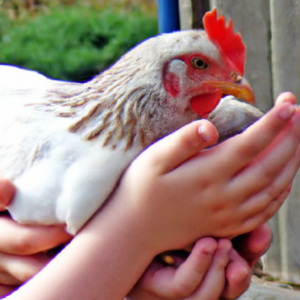
So, you’ve recently made the decision to move your chickens to a new coop or introduce them to a different environment. But now you’re left wondering, how exactly do you go about acclimating them? It’s a question that many chicken owners find themselves asking, and luckily, there are a few key steps you can take to ensure a smooth transition for your feathered friends. In this article, we’ll explore the best methods for acclimating chickens to their new surroundings, from gradual introductions to providing a comfortable and secure living space. By following these tips, you’ll have your chickens feeling right at home in no time.

Choosing the Right Coop for Your Chickens
Understanding the Needs of Your Chickens
When choosing a coop for your chickens, it is essential to consider their specific needs. Different chicken breeds have different requirements in terms of space, ventilation, and nesting areas. Consider factors such as the size of your flock, the climate in your area, and the level of protection needed from predators. Understanding the needs of your chickens will help you make an informed decision when selecting the right coop.
Considering the Size and Design of the Coop
The size of the coop is crucial to ensure the comfort and well-being of your chickens. As a general rule of thumb, each chicken requires around 4 square feet of space inside the coop. However, providing extra space is always beneficial, allowing them to move freely and engage in natural behaviors.
In terms of design, the coop should have a solid structure to protect against predators and adverse weather conditions. It should also have proper insulation and a secure roof to prevent leaks. Additionally, consider features such as easy-access doors for cleaning, windows for natural light, and removable nesting boxes for convenience.
Ensuring Proper Ventilation and Lighting
Good ventilation is crucial to maintaining a healthy coop environment for your chickens. Proper airflow helps remove moisture, ammonia, and odors, reducing the risk of respiratory issues and promoting overall well-being. Ensure that the coop has vents or windows that can be opened and closed as needed to regulate temperature and air circulation.
Lighting also plays a significant role in the well-being of your chickens. Natural light is essential for their daily rhythm and egg production. If the coop does not have enough natural light, consider installing LED bulbs with a spectrum similar to sunlight to provide adequate lighting.
Providing Adequate Nesting and Roosting Space
Chickens require a suitable area for nesting and roosting to feel secure and comfortable. Provide nesting boxes that are dark, quiet, and filled with soft bedding material such as straw or wood shavings. A general recommendation is to have one nesting box for every four to five hens.
Roosting bars or perches should also be provided, as chickens naturally seek elevated spaces to sleep. Ensure that the roosts are wide enough for the chickens to grasp comfortably and positioned away from the nesting boxes to prevent soiling.
Preparing the Coop before Transferring Chickens
Cleaning and Disinfecting the Coop
Before transferring your chickens to a new coop, it is essential to thoroughly clean and disinfect the space. Remove all existing bedding, droppings, and debris from the coop. Use a mild detergent or poultry-specific disinfectant to clean all surfaces, including walls, perches, nesting boxes, and flooring.
Rinse everything thoroughly and allow it to dry completely before adding fresh bedding and nesting material. Proper cleaning and disinfection help eliminate any pathogens or parasites that may harm your chickens’ health.
Checking for Any Structural Issues
Inspect the new coop for any structural issues that may pose a risk to your chickens’ safety. Look for loose wires, sharp edges, or gaps in the walls or flooring that could allow predators to enter. Repair any damages and reinforce weak spots to ensure the coop is secure and free from potential hazards.
Adding Bedding and Nesting Material
Once the coop is clean and dry, add fresh bedding material to provide a comfortable and hygienic space for your chickens. Straw, wood shavings, or shredded paper are commonly used as bedding material. Fill the nesting boxes with clean, soft nesting material to create inviting nests for your hens.
Ensuring Availability of Food and Water
Before transferring your chickens to the new coop, ensure that food and water sources are readily available. Place feeders and waterers in accessible locations within the coop, away from potential contamination. Familiarize your chickens with the placement and accessibility of these resources to avoid any confusion or stress during the transition.

Gradual Introduction to the New Coop
Keeping the Chickens Confined in the Coop
Upon transferring your chickens to the new coop, it is advisable to keep them confined within the coop for a few days. This confinement allows them to acclimate to the new environment and reduces the risk of them getting lost or becoming disoriented.
Allowing Them to Familiarize with the Surroundings
After a few days of confinement, slowly introduce your chickens to their outdoor surroundings. Open the door of the coop during the daytime, allowing them to explore the immediate vicinity. Keep a close eye on their behavior and interactions to ensure their safety and comfort.
Monitoring the Chickens’ Behavior and Health
During the acclimation period, closely monitor your chickens’ behavior and health. Look for signs of distress, such as excessive pecking or feather picking, unusual aggression, or withdrawal. Additionally, observe their eating and drinking habits, as any significant changes may indicate underlying health issues.
Gradually Expanding Their Outdoor Access
As your chickens become more familiar with their surroundings, gradually increase their outdoor access. Let them explore larger areas during the day while ensuring they have a safe place to retreat to if needed. This gradual expansion allows them to fully adjust to their new coop and environment while minimizing stress.
Establishing a Routine
Maintaining Consistency in Feeding Times
Establishing a consistent feeding routine is vital for your chickens’ overall well-being and productivity. Feed them at the same time each day, offering a balanced diet appropriate for their age and breed. Ensure that they have access to fresh water at all times, and regularly clean and refill the waterers to prevent contamination.
Establishing Regular Cleaning Schedule
Maintaining cleanliness in the coop is essential for your chickens’ health and comfort. Establish a regular cleaning schedule, removing any soiled bedding, droppings, or debris. This routine cleaning prevents the buildup of harmful bacteria, parasites, and unpleasant odors.
Providing Enrichment Activities
Chickens are naturally curious and active creatures. Encourage their natural behaviors by providing enrichment activities in the coop. Scatter treats or food puzzles to stimulate foraging instincts, hang secure toys such as pecking balls or mirrors, or introduce simple perches and roosts at different heights to keep them physically engaged.
Introducing Supportive Flock Members
To foster a sense of security and camaraderie within the flock, consider introducing supportive flock members. Adding gentle and calm chickens can help alleviate stress and minimize the risk of bullying or pecking order issues. Monitor their interactions closely during the introduction process to ensure a smooth integration.

Ensuring Safety and Security
Securing the Coop from Predators
Protecting your chickens from predators is paramount. Inspect the coop regularly for potential entry points, such as holes in the walls or flooring, and secure them with sturdy materials. Reinforce windows and vents with predator-proof mesh or wire. Additionally, consider installing a sturdy lock or latches on doors to prevent unauthorized access.
Checking for Potential Hazards in the Environment
Ensure that the immediate environment surrounding the coop is free from potential hazards. Remove any poisonous plants, sharp objects, or toxic substances that could harm your chickens. Regularly inspect the area for any loose wires, tools, or other items that could cause accidents or injuries.
Ensuring Proper Fencing and Netting
Installing proper fencing around the coop and outdoor areas is essential to protect your chickens from predators and prevent them from wandering off. Choose fencing materials that are strong and securely anchored to the ground. Additionally, cover the entire outdoor area with netting or wire mesh to deter aerial predators such as hawks or owls.
Installing Automatic Lighting and Security Systems
To enhance the safety and security of your chickens, consider installing automatic lighting and security systems in and around the coop. Motion-activated lights can deter predators and intruders, while surveillance cameras provide additional monitoring and peace of mind. These systems help ensure the well-being of your chickens, even during nighttime.
Monitoring and Assessing Adjustment Progress
Observing Changes in Behavior and Activity Levels
Monitor your chickens’ behavior and activity levels closely during the adjustment period. Pay attention to any changes, such as increased exploration, social interactions, or vocalizations, as these could indicate their growing comfort and adaptation to the new coop. Conversely, any sudden changes in behavior, such as constant hiding or isolation, may signal underlying issues requiring attention.
Monitoring Egg Production and Quality
If your chickens are of laying age, closely monitor their egg production and quality. As they acclimate to the new coop, there may be slight fluctuations in egg production. However, if you notice a significant decrease or prolonged absence of eggs, it may indicate stress or health issues. Consult a veterinarian if necessary.
Checking for Signs of Stress or Illness
Regularly check your chickens for any signs of stress or illness. Look for physical symptoms such as abnormal feather loss, changes in appetite, diarrhea, or difficulty breathing. Monitor their posture, gait, and overall appearance for any abnormalities. Promptly address any health concerns by seeking veterinary advice.
Making Necessary Adjustments to Accommodate Their Needs
As you closely monitor your chickens’ adjustment progress, you may need to make necessary adjustments to accommodate their evolving needs. This could include modifying the coop layout, adding additional perches or nesting boxes, or adjusting the feeding routine. Being attentive and responsive to their needs will help create a comfortable and thriving environment.
Addressing Challenges and Potential Issues
Dealing with Bullying or Pecking Order Issues
When introducing chickens to a new coop or flock, it is not uncommon to experience bullying or pecking order issues as they establish a hierarchy. To address this, provide multiple food and water sources to reduce competition, ensure adequate space and hiding spots, and closely monitor their interactions. If severe bullying persists, consider separating the aggressive chicken temporarily to restore harmony.
Introducing New Chickens to an Existing Flock
When introducing new chickens to an existing flock, gradual integration is key. Start by placing the new chickens in a separate but adjacent area within the coop, allowing them to see and smell each other without direct contact. After a period of observation and adjustment, introduce them in a supervised manner, closely monitoring their interactions for signs of aggression or distress.
Managing Excessive Noise or Disturbance
Chickens can be noisy, especially during times of stress, mating, or when startled. However, excessive noise or disturbance can be bothersome, particularly if you have close neighbors. To manage noise, ensure that your chickens’ basic needs are met and their environment is enriched with activities and perches. Providing distractions and reducing stressors can help minimize excessive noise.
Preventing or Treating Common Health Problems
Chickens are susceptible to various health issues, including parasites, respiratory infections, and nutritional deficiencies. Establish a routine for regular health checks, including examining their eyes, beaks, combs, legs, and vent. Consult with a veterinarian for advice on preventive measures, vaccinations, and treatment protocols to keep your chickens healthy and thriving.
Providing Environmental Enrichment
Creating Dust Baths and Scratching Areas
Chickens enjoy taking dust baths as part of their natural grooming behavior. Provide a designated area within the coop or outdoor space filled with fine sand or dirt for them to indulge in this activity. Additionally, create designated scratching areas by adding loose soil or mulch, encouraging their natural instinct to scratch and forage for insects.
Providing Perches and Elevated Spaces
Chickens naturally prefer perches and elevated spaces for resting, sleeping, and observing their surroundings. Install perches of varying heights and widths to accommodate different sizes and ages of chickens. Elevated spaces give them a sense of security and peace, making them feel more comfortable in their coop.
Providing Access to Greens and Foraging Opportunities
Allowing chickens access to fresh greens and foraging opportunities contributes to their overall well-being. Create a chicken-friendly garden area where they can graze on grass, weeds, and other edible plants. Utilize movable chicken pens or rotate their access to different areas of your yard to provide a continuous supply of fresh forage.
Including Toys and Interactive Elements
Keeping chickens mentally stimulated is essential for preventing boredom and behavioral problems. Introduce toys and interactive elements to the coop environment to engage their natural curiosity. Hang treat balls filled with grains or fruits, provide pecking blocks with edible rewards, or suspend shiny objects or mirrors to entertain and engage your chickens.
The Role of Weather and Seasons
Preparing the Coop for Different Climate Conditions
Your coop should be designed to accommodate different weather conditions throughout the year. Consider insulation to keep the coop warm during winter and well-ventilated openings to prevent overheating during summer. Provide shade structures outside the coop to protect your chickens from extreme heat, and ensure proper waterproofing to keep them dry during rainy seasons.
Adjusting Feeding and Watering Practices
As the seasons change, adjust your chickens’ feeding and watering practices accordingly. In colder months, ensure that the water does not freeze by using heated waterers or regularly replacing water with warm alternatives. Conversely, during hot weather, provide cool water and consider adding electrolytes to their drinking water to help them stay hydrated.
Ensuring Adequate Ventilation and Temperature Regulation
Proper ventilation is crucial throughout the year to maintain optimal air quality and temperature within the coop. Install adjustable windows or vents to control airflow during different seasons. Monitor temperature levels inside the coop and make adjustments as needed to ensure a comfortable and healthy environment for your chickens.
Addressing Seasonal Concerns such as Molting
Molting is a natural process in chickens where they shed old feathers and grow new ones. During this period, chickens may experience a decrease in egg production and appear unkempt. Make sure to provide a well-balanced diet high in protein, as it is necessary for feather growth. Be patient and supportive during molting season, as it is a temporary phase.
Seeking Professional Advice and Support
Consulting Local Veterinarians or Poultry Experts
If you have specific concerns or questions regarding your chickens’ health or well-being, it is recommended to consult with local veterinarians or poultry experts. They can provide valuable guidance tailored to your specific circumstances, including vaccination protocols, disease prevention, and treatment options.
Joining Community or Online Chicken-Keeping Groups
Joining local community groups or online forums dedicated to chicken-keeping can be an excellent source of support and knowledge. You can connect with experienced chicken owners, share experiences, and seek advice on a wide range of topics, from coop building to poultry health. These communities can provide a sense of camaraderie and reassurance, especially for novice chicken keepers.
Attending Workshops or Webinars on Poultry Care
Attending workshops or webinars on poultry care can be an enriching experience for both novice and seasoned chicken keepers. These educational events cover various aspects of chicken husbandry, from coop design and management to health and nutrition. Participating in such events allows you to gain valuable insights from experts in the field and stay up to date with current practices.
Utilizing Resources from Agricultural Extension Offices
Agricultural extension offices often provide a wealth of resources and information on raising chickens. They offer educational publications, workshops, and expert advice tailored to local conditions. Contact your local extension office to access resources that can help you make informed decisions and enhance your chicken-keeping skills.
In conclusion, acclimating chickens to a new coop or environment requires careful planning, attention to their needs, and gradual introductions. By understanding their requirements, providing a suitable living space, and ensuring their safety and well-being, you can create a comfortable and enriching environment for your feathered friends. Remember, seeking professional advice and support, as well as being observant and responsive to their behavior and health, will contribute to a successful transition and thriving flock.







